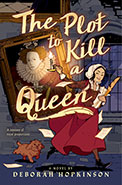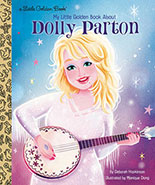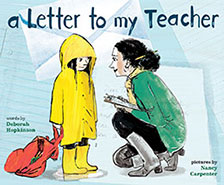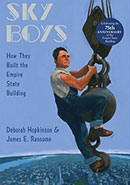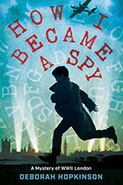Up Before Daybreak
Cotton and People in America
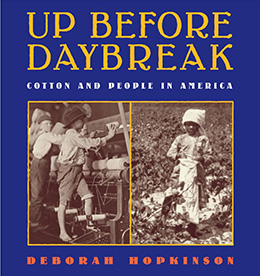
Awards and Accolades
- ALA Notable Book
- Carter G. Woodson Honor
- Junior Library Guild selection
- Phoenix Award, Children’s Literature Association
What is this book about?
In this stunning nonfiction volume, author Deborah Hopkinson weaves the stories of slaves, sharecroppers, and mill workers into a tapestry illuminating the history of cotton in America.
In Up Before Daybreak, author Deborah Hopkinson captures the voices of the forgotten men, women, and children who worked in the cotton industry in America over the centuries. The voices of the slaves who toiled in the fields in the South, the poor sharecroppers who barely got by, and the girls who gave their lives to the New England mills spring to life through oral histories, archival photos, and Hopkinson’s engaging narrative prose style. These stories are amazing and often heartbreaking, and they are imbedded deep in our nation’s history.
Reviews
“Making excellent use of primary sources (even noting when these sources may be less than accurate) and extended with black-and-white photos and period reproductions, this excellent work gives a detailed picture of the effect of cotton production on the social structure of the United States. From 1607, when the earliest English settlers arrived in Virginia, cotton was among the plants grown in colonial gardens. With the onset of the Industrial Revolution in England, the demand for it increased, and the southern colonies found it lucrative to step up production. That cotton culture was part and parcel of the slave system becomes clear in this thoughtfully composed volume. Hopkinson also considers the young women who flocked to Lowell, MA, and the surrounding area to work in the textile factories. After the Civil War, the southern economy remained dependent on cotton, trading the slave system for a sharecropping system, and moving many of the mills to the south. Following workers’ histories up through the Great Depression, the final chapter discusses child labor in the past and present. This informative work extends titles such as Arthur John L’Hommedieu’s From Plant to Blue Jeans (Scholastic Library, 1998). A first-rate report and research source.” (Ann Welton, School Library Journal, starred review)
“The author of Shutting Out the Sky: Life in the Tenements (2003) here explains to middle-graders how ‘the story of cotton … is like a thread that stretches far back into America’s past.’ In unraveling that thread from the industrial revolution to the 1950s demise of the Lowell cotton mills, Hopkinson discusses the history and sociology of king cotton, frequently emphasizing the children who labored under slave masters, endured dead-end mill jobs, or helped sharecropping parents claw out a living. Stories of real people, such as mill girl Lucy Larcom who escaped the ‘incessant clash’ of the looms to become a famous poet, sharply focus the dramatic history, as do arresting archival photos of stern youngsters manipulating hoes, cotton sags, or bobbins. Neither too long nor too dense, this won’t intimidate students reluctantly tackling research projects, and teachers and children alike will welcome the concluding list of suggested readings for youth, the scholarly bibliography, and thorough endnotes. Rarely have the links between northern industry, southern agriculture, slavery, war, child labor, and poverty been so skillfully distilled for this audience.” (Jennifer Mattson, Booklist, starred review)
“‘The voices of children weave through the story of cotton,’ and the story of cotton weaves through the story of our nation. Drawing on oral histories from the Federal Writers project of the 1930s and the oral-history interviews with Lowell mill workers in the 1970s and 1980s, Hopkinson makes history come alive through the voices of the people. Real people’s stories are woven into a rich narrative of the history: clothmaking, the cotton gin, slavery, the Great Migration, the Great Depression and the continuing problem of child labor around the world. This volume, like the author’s Shutting Out the Sky (2003), is a model of superb nonfiction writing and how to use primary sources to create engaging narratives. The prose is clear, the documentation excellent and well-selected photographs support the text beautifully. What might have been a dry topic is lively, the voices of the children vivid and personal. ” (Kirkus Reviews, starred review)
“Cotton has always been vital to the U.S. economy; here Hopkinson focuses on the hard lives of the people, especially the children, who raised the crop, took it to market, and turned it into cloth. Beginning with a quick history, she continues chronologically with chapters describing the world of “king” cotton — for slaves in southern fields and young women in northern mills (using Lowell, Massachusetts, as an example) — before the Civil War and after, when both growth and processing became dispersed, and the factories closed. Anecdotal vignettes from oral history enliven Hopkinson’s account (and the author includes a helpful reminder of the limits of this material). A generous selection of historical photographs, documents, and illustrations, undated but attributed in the captions, accompanies the text. Generous, too, is the back matter, which includes appropriate suggestions for further reading, a selected bibliography, chapter notes, more specific photo credits, and an extensive index. This history really ends in the 1950s with the closing of the last mills in Lowell, but the author brings the story of child labor up to date with a reminder that children are still employed in cotton production in other countries.” (Kathleen Isaacs, The Horn Book)

author, Deborah Hopkinson
Scholastic Focus
ages 8 and up, 2006
ISBN 978–0439639019
Please find this book at your favorite local library or used bookstore.
